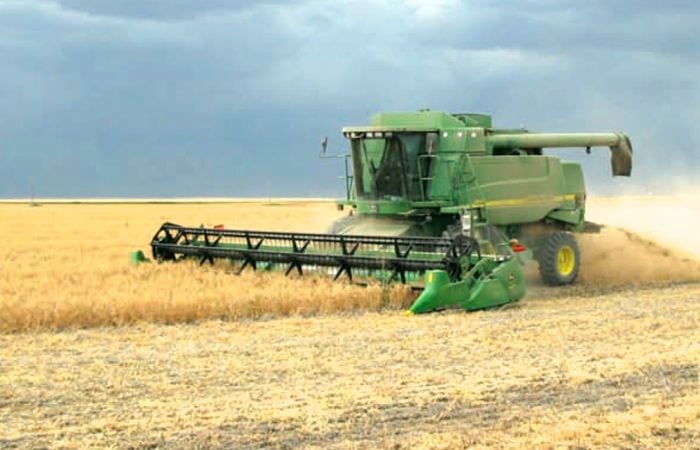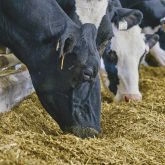MINOT, N.D. — Dave Franzen of North Dakota State University believes in following the data.
So when North Dakota field data indicated that long-term no-till fields require less nitrogen than conventionally tilled soils, the extension soil specialist told no tillage farmers to cut their nitrogen rates by 50 pounds per acre.
“That’s the just way it worked out in the data. The data said 50 (lbs. per acre), so I used 50,” Franzen said.
The recommendations apply to only wheat and durum.
“I only put out recommendations on things that I test,” he said.
Read Also

Good progress made in Sask. harvest
Combining in Saskatchewan is in the home stretch as the province’s agriculture department reported it at 84 per cent complete. Although the harvest advanced 16 points during the week ended Sept. 29, it was eight points behind the five-year average.
“I don’t have any numbers to support (this) for sunflowers or anything else…. Unless I have any numbers, I’m not going to pull anything out of my back pocket. I’ve done the wheat and durum (research), so that’s out there.”
NDSU has said for the last several years that farmers growing wheat on fields with continuous no-till for more than five years require 50 lb. less nitrogen per acre than conventionally tilled fields.
Franzen is also developing nitrogen guidelines for corn grown on long-term zero till fields.
He devised the wheat recommendation after studying North Dakota zero tillage data going back to the 1970s and conducting his own research from 2005-10.
“I started working on it in 2005 and we gathered another 50 to 60 sites,” he said.
“No preconceived ideas. I just divided the sites into those that I knew were on a long-term no till and those that I knew were conventional.”
Franzen initiated the research after speaking to long-term no-tillage farmers in the state who claimed they could produce normal yields with less nitrogen.
“I started (working) on the response curves and I’ll be damned that they weren’t right,” Franzen said.
“If you look at a certain yield and the nitrogen it took to produce it in a no-till (system) and the protein at a certain level and the nitrogen it took to reach that level in the no-till, it took about 50 lb. of N less with the long-term no till.”
Mark Jennings, a zero till farmer from Washburn, N.D., hadn’t heard of the NDSU recommendation until it was mentioned at the Manitoba-North Dakota Zero Tillage Farmers Association annual meeting in Minot in early January.
However, he has already reduced the amount of nitrogen he applies to his fields, so the recommendation wasn’t a surprise.
“Can you jump on it and say it’s exactly 50 lb.? I don’t know,” he said.
“From my anecdotal data and from what I see in my soil tests, I know there’s something happening.”
As an example, post harvest nitrogen tests on one of Jennings’ high yielding sunflower crops showed 90 to 130 lb. of nitrogen remained in the soil.
“You don’t expect to see (that) after a really good crop. You expect to see a lot of removal,” he said
“But (no tillers) can’t be too shocked, because you’re taking all these steps to make that happen…. You’re doing things that are beneficial and now you’re starting to see some results from it.”
Franzen said he doesn’t know why long-term no-till fields need less nitrogen. His theory is that no-till soil uses nitrogen more efficiently, thanks to the diverse population of organisms.
“That’s the thing that changes after about six years…. You double the amount of bugs that are there and the nature of bugs is more diverse as well,” he said.
“When you apply nitrogen … it’s utilized by micro-organisms and every organism in between. They slime and they poop and they do all this stuff, so it’s in a more organic form for a longer time during the season. It kind of acts like a slow release N.”
Cultivating a diverse community of soil organisms requires more than just zero tillage, Franzen added.
Growers also need a varied crop rotation, perhaps with five or six crops.
“I think it’s only in those situations that you’re going to get this enhanced biology and the (nitrogen) efficiency factor.”
Franzen said NDSU is the only state extension service that recommends less nitrogen for zero-till fields.
He cautioned that the 50 lb. recommendation is for committed no-tillage farmers who “stick to it through thick and thin.”
As for Western Canada, Franzen said growers north of the border shouldn’t act on his recommendations.
Instead, prairie wheat farmers should encourage Canadian scientists to study the fertility of no-till systems.
“It will probably be different than here. It might be better or might be worse,” he said.
“(But) I’d be shocked if something wasn’t going on there.”















